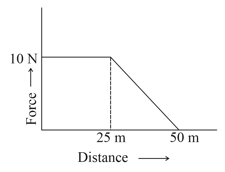It is well known that a raindrop or a small pebble falls under the influence of the downward gravitational force and the opposing resistive force. The resistive force is known to be proportional to the speed of the drop. Consider a drop or small pebble of falling (from rest) from a cliff of height . It hits the ground with a speed of What is the work done by the unknown resistive force?

Important Questions on Work, Energy and Power
A body of mass initially at rest moves under the action of an applied horizontal force of on a table with the coefficient of kinetic friction . Compute the
(a) work done by the applied force in .
(b) work done by the friction in .
(c) work done by the net force on the body in .
(d) change in kinetic energy of the body in , and interpret your results.
A body of mass is acted upon by a variable force. The force varies with the distance covered by the body. What is the speed of the body when the body has covered ? Assume that the body starts from rest.

Consider the situation shown in the figure. Initially the spring is undeformed when the system is released from rest. Assuming no friction in the pulley, find the maximum elongation of the spring.

A rigid body of mass is taken slowly up an inclined plane of length and height (assuming the applied force to be parallel to the inclined plane), and then allowed to slide down to the bottom again. The coefficient of friction between the body and the plane is Using find the

(a) work done by the gravitational force over the round trip.
(b) work done by the applied force over the upward journey
(c) work done by frictional force over the round trip.
(d) kinetic energy of the body at the end of the trip?
